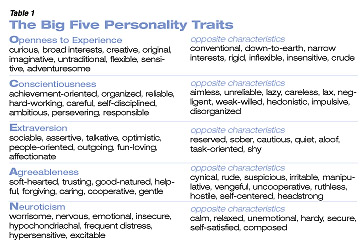My intent with this series of columns, is to stir the pot, to stimulate thinking and conversations among safety and health professionals and hopefully some breakthrough research on the role of personality traits and states in achieving an injury-free workplace. Clearly, there is much to be gained from a better understanding of how personality characteristics affect safety performance.
Increasing risks
For instance, I believe, as I stated in my May column, that certain personality characteristics increase the chance that an individual will perform at-risk behaviors and experience an unintended injury. Other personality dimensions influence one’s willingness to engage in injury preventive behaviors. In other words, there are personality factors that contribute to injury proneness, and other factors that lead to injury preventiveness.
Sometimes, a personality factor can work both ways. For example, one research study showed that people who scored high on a measure of personal control were more likely to take risks, making them more injury prone. But these individuals were also more likely to follow safety precautions, making them more injury preventive.
States & traits
We can’t get too far into a discussion of personality factors and safety performance without distinguishing between personality states and traits, which was the topic of my April column. I’m biased to the state perspective. This is the idea that personality is dramatically shaped by the environmental context. That is, personality characteristics are not etched in stone, but fluctuate according to the situation. For example, a person might be an optimistic success-seeker in recreational activities but be a pessimistic failure avoider when it comes to work.
This is what you find in most self-help books and audiotapes. Change conditions of your situation and follow certain self-management steps and you can improve your attitude, behavior and even career success. You can be whatever you want to be, proclaim some of these pop psychologists. It’s a matter of changing your “state†of mind.

Limits of change
Of course we simply cannot become any kind of person we’d like to become, even if all the relevant environmental variables are on our side. We do face physical limitations. And certain personality characteristics are indeed genetically determined and inherited, according to psychological research conducted in the past two decades.For example, a systematic comparison of identical twins reared apart after only five months of age with twins raised together showed that those twin pairs raised in the same home were not more similar than those raised separately in respect to various personality traits.
This and similar research has led to the conclusion that genetics account for about 50 percent of individual differences in personality.
So recent psychological research has swung the pendulum back toward the nature side of the nature/nurture question. This doesn’t diminish environmental factors as being inconsequential. Behavior is determined by an interaction of the context in which we perform with personality characteristics. Sometimes situations are the primary determinant of behavior, sometimes personality shapes behavior.

Primary factors
Now to take our discussion of personality further, let’s examine personality types. Every research-based textbook among more than 20 I consulted that covered personality traits identified the same five primary person factors.Table 1 identifies these traits as bipolar dimensions, referred to in the research literature as the “Big Five.†Note that the order of the dimensions presented in Table 1 spell the word “ocean,†making it easy to remember these critical personality characteristics.
These dimensions remain relatively stable over an individual’s lifetime, and carry across (generalize) cultural lines, according to substantial research conducted in the 1990s. Plus, the “Big Five†personality traits have been found to be 40 percent to 60 percent inheritable.
Table 2 provides a few representative questions per each of the “Big Five†traits. Higher numbers reflect qualities of the particular trait, except for those items followed by an “R.†These need to be reverse scored, meaning the number circled should be subtracted from “6†to make the score consistent with other items.
Please don’t consider your totals on these select items to be a valid measure of the “Big Five.†Rather, read them to improve your understanding of each trait, and use individual scores to trigger conversations about these constructs and their relation to safety-related behaviors. How do the “Big Five†affect safety performance?
We don’t really know the answer to that – yet. Research to date has not studied specific connections between “Big Five†traits and injury proneness or injury preventiveness.
But still, certain relations between these personality traits and safety-related behaviors seem reasonable and worth our serious consideration:
These hypotheses reflect only a few of the possible ways the “Big Five†could influence workplace safety. Clearly, we need systematic research in this area, especially given the pervasive behavioral influence of these five genetically determined dimensions of human personality. As I mentioned at the outset, we have much to learn about personality that could benefit our safety initiatives in the workplace.